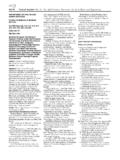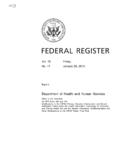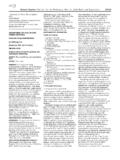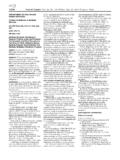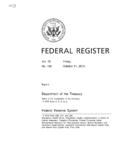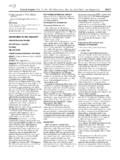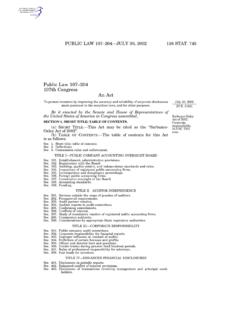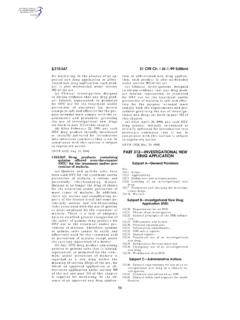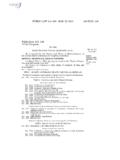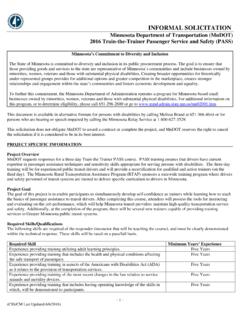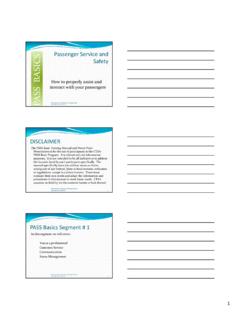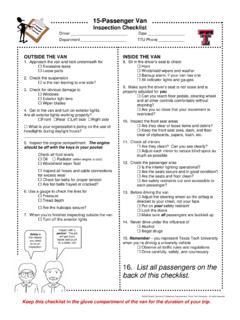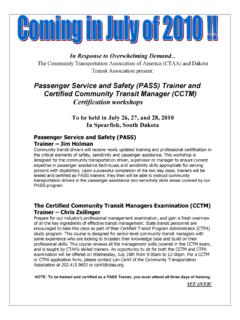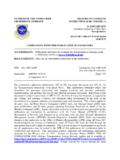Transcription of SUBCHAPTER T—SMALL PASSENGER VESSELS (UNDER 100 …
1 177 SUBCHAPTER T SMALL PASSENGER VESSELS ( under 100 gross TONS) PART 175 GENERAL PROVISIONS Sec. Purpose. General applicability. Specific applicability for individual parts. Applicability to offshore supply ves-sels. VESSELS operating under an exemp-tion afforded in the PASSENGER vessel safety Act of 1993 (PVSA). VESSELS on an international voyage. Load lines. gross tonnage as criterion for re-quirements. Definitions of terms used in this sub-chapter. Equivalents. Special consideration. Appeals. Incorporation by reference. Approved equipment and material. OMB control numbers. AUTHORITY: 46 2103, 3205, 3306, 3703; Pub. L. 103 206, 107 Stat. 2439; 49 App. 1804; Department of Homeland Security Dele-gation No.
2 ; also issued under 44 3507. SOURCE: CGD 85 080, 61 FR 947, Jan. 10, 1996, unless otherwise noted. Purpose. The purpose of this SUBCHAPTER is to implement applicable sections of Sub-title II of Title 46, United States Code, which require the inspection and cer-tification of small PASSENGER VESSELS . General applicability. (a) Except as in paragraph (b) of this section, this SUBCHAPTER applies to each vessel of less than 100 gross tons that carries 150 or less passengers, or has overnight accommodations for 49 or less passengers, and that (1) Carries more than six passengers, including at least one for hire; (2) Is chartered with a crew provided or specified by the owner or the own-er s representative and is carrying more than six passengers; (3) Is chartered with no crew provided or specified by the owner or the own-er s representative and is carrying more than 12 passengers; or (4) If a submersible vessel , carries at least one PASSENGER for hire; or (5) Is a ferry carrying more than six passengers.
3 NOTE TO PARAGRAPH(a): For a vessel of less than 100 gross tons that carries more than 150 passengers or has overnight accommoda-tions for more than 49 passengers, see sub-chapter K of this chapter. (b) This SUBCHAPTER does not apply to: (1) A vessel operating exclusively on inland waters that are not navigable waters of the United States; (2) An oceanographic research vessel ; (3) A boat forming part of a vessel s lifesaving equipment and that is not used for carrying passengers except in emergencies or during emergency drills; (4) A vessel of a foreign country that is a party to the International Conven-tion for the safety of Life at Sea, 1974, as amended (SOLAS), to which the United States Government is currently a party, and that has on board a cur-rent valid SOLAS PASSENGER Ship Safe-ty Certificate.
4 Or (5) A vessel of a foreign country, whose government has inspection laws approximating those of the United States and that by its laws accords similar privileges to VESSELS of the United States, which has on board a current valid certificate of inspection, permitting the carrying of passengers, issued by its government. [CGD 85 080, 61 FR 947, Jan. 10, 1996; 61 FR 20557, May 7, 1996, as amended at 62 FR 51355, Sept. 30, 1997; USCG 2008 1107, 74 FR 63664, Dec. 4, 2009] Specific applicability for in-dividual parts. At the beginning of certain parts of this SUBCHAPTER , a more specific appli-cation is given for all or particular por-tions of that part. This application sets forth the type, size, service, or age of a vessel to which certain portions of that part apply or particular dates by which an existing vessel must comply with certain portions of that part.
5 VerDate Mar<15>2010 11:05 Nov 21, 2012 Jkt 226202 PO 00000 Frm 00187 Fmt 8010 Sfmt 8010 Y:\SGML\ 226202pmangrum on DSK3 VPTVN1 PROD with CFR178 46 CFR Ch. I (10 1 12 Edition) Applicability to offshore sup-ply VESSELS . (a) Existing OSVs of more than 15 but less than 100 gross tons are subject to inspection under this SUBCHAPTER . New OSVs of more than 15 but less than 100 gross tons are subject to inspection under SUBCHAPTER L of this chapter. (b) Each existing OSV permitted grandfathering under paragraph (a) of this section must complete construc-tion and have a Certificate of Inspec-tion by March 16, 1998. [CGD 82 004 and CGD 86 074, 62 FR 49355, Sept. 19, 1997] VESSELS operating under an exemption afforded in the Pas-senger vessel safety Act of 1993 (PVSA).
6 (a) The PASSENGER vessel safety Act of 1993 (PVSA) contained an allowance for the exemption of certain PASSENGER VESSELS that are (1) At least 100 gross tons but less than 300 gross tons; or (2) Former public VESSELS of at least 100 gross tons but less than 500 gross tons. (b) The owner or operator of a vessel must have applied for an exemption under PVSA by June 21, 1994, and then brought the vessel into compliance with the interim guidance in Naviga-tion and Inspection Circular (NVIC) 7 94 not later than December 21, 1996. The PVSA exemption is valid for the serv-ice life of the vessel , as long as the ves-sel remains certified for PASSENGER service. If the Certificate of Inspection (COI) is surrendered or otherwise be-comes invalid (not including a term while the vessel is out of service but undergoing an inspection for recertifi-cation), the owner or operator must meet the appropriate inspection regu-lations to obtain a new COI without the PVSA exemption.
7 (c) Except where the provisions of SUBCHAPTER H of this chapter apply, the owner or operator must ensure that the vessel meets the requirements of this SUBCHAPTER , meets any requirements the OCMI deems applicable, and meets any specific additions or exceptions as follows: (1) If a vessel does not meet the in-tact stability requirements of sub-chapter S of this chapter, the vessel s route(s) will be limited to an area with-in 20 nautical miles from a harbor of safe refuge, provided the vessel has a history of safe operation on those waters. The OCMI may further restrict the vessel s routes if the vessel s serv-ice history, condition, or other factors affect its seaworthiness or safety . (2) The vessel may not carry more than 150 passengers, and not more than 49 passengers in overnight accommoda-tions.
8 (3) The owner or operator must crew the vessel under the requirements of this SUBCHAPTER . All officers must be endorsed for the appropriate vessel ton-nage. The OCMI may require an appro-priately endorsed engineer officer for those VESSELS of at least 200 gross tons. VESSELS carrying more than 50 pas-sengers must have an additional deck-hand, and all deckhands on VESSELS car-rying more than 50 passengers must be adequately trained. The crew members on a vessel of at least 200 gross tons, except those operated exclusively on lakes and rivers, are required to hold merchant mariner credentials or mer-chant mariner documents and 50 per-cent of the merchant mariner creden-tials or at least an able seaman. (4) The vessel owner or operator must comply with the lifesaving arrange-ments located in part 180 of this chap-ter, except that inflatable liferafts are required for primary lifesaving.
9 A res-cue boat or suitable rescue arrange-ment must be provided to the satisfac-tion of the OCMI. (5) The vessel owner or operator must comply with the fire protection re-quirements located in part 181 of this chapter. When a vessel fails to meet the fire protection and structural fire protection requirements of this sub-chapter, the vessel owner or operator must meet equivalent requirements to the satisfaction of the cognizant OCMI or submit plans for approval from the Coast Guard Marine safety Center. (6) At a minimum, the owner or oper-ator must outfit the vessel with port-able fire extinguishers per 46 CFR In addition, the vessel must meet any additional requirements of the OCMI, even if they exceed the requirements in 46 CFR VerDate Mar<15>2010 11:05 Nov 21, 2012 Jkt 226202 PO 00000 Frm 00188 Fmt 8010 Sfmt 8010 Y:\SGML\ 226202pmangrum on DSK3 VPTVN1 PROD with CFR179 Coast Guard, DHS (7) In addition to the means-of-escape requirements of 46 CFR , the ves-sel owner or operator must also meet the requirements for means of escape found in 46 CFR 40.
10 (d) The OCMI conducts an inspection and may issue a COI if the vessel meets these requirements. The COI s condi-tion of operation must contain the fol-lowing endorsement: This vessel is op-erating under an exemption afforded in The PASSENGER vessel safety Act of 1993 and as such is limited to domestic voyages and a maximum lll of pas-sengers and may be subject to addi-tional regulations and restrictions as provided for in Sections 511 and 512 of the Act. [USCG 1999 5040, 67 FR 34799, May 15, 2002, as amended by USCG 2006 24371, 74 FR 11266, Mar. 16, 2009] VESSELS on an international voyage. A mechanically propelled vessel that carries more than 12 passengers on an international voyage must comply with the applicable requirements of SOLAS, as well as this SUBCHAPTER .
